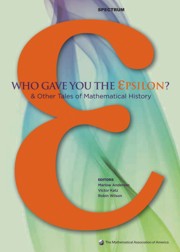Book contents
- Frontmatter
- Introduction
- Contents
- Analysis
- Geometry, Topology and Foundations
- Algebra and Number Theory
- Foreword
- Hamilton's Discovery of Quaternions
- Hamilton, Rodrigues, and the Quaternion Scandal
- Building an International Reputation: The Case of J. J. Sylvester (1814–1897)
- The Foundation Period in the History of Group Theory
- The Evolution of Group Theory: A Brief Survey
- The Search for Finite Simple Groups
- Genius and Biographers: The Fictionalization of Evariste Galois
- Hermann Grassmann and the Creation of Linear Algebra
- The Roots of Commutative Algebra in Algebraic Number Theory
- Eisenstein's Misunderstood Geometric Proof of the Quadratic Reciprocity Theorem
- Waring's Problem
- A History of the Prime Number Theorem
- A Hundred Years of Prime Numbers
- The Indian Mathematician Ramanujan
- Emmy Noether
- “ Marvelous Proof,”
- Afterword
- Surveys
- Index
- About the Editors
The Evolution of Group Theory: A Brief Survey
from Algebra and Number Theory
- Frontmatter
- Introduction
- Contents
- Analysis
- Geometry, Topology and Foundations
- Algebra and Number Theory
- Foreword
- Hamilton's Discovery of Quaternions
- Hamilton, Rodrigues, and the Quaternion Scandal
- Building an International Reputation: The Case of J. J. Sylvester (1814–1897)
- The Foundation Period in the History of Group Theory
- The Evolution of Group Theory: A Brief Survey
- The Search for Finite Simple Groups
- Genius and Biographers: The Fictionalization of Evariste Galois
- Hermann Grassmann and the Creation of Linear Algebra
- The Roots of Commutative Algebra in Algebraic Number Theory
- Eisenstein's Misunderstood Geometric Proof of the Quadratic Reciprocity Theorem
- Waring's Problem
- A History of the Prime Number Theorem
- A Hundred Years of Prime Numbers
- The Indian Mathematician Ramanujan
- Emmy Noether
- “ Marvelous Proof,”
- Afterword
- Surveys
- Index
- About the Editors
Summary
This article gives a brief sketch of the evolution of group theory. It derives from a firm conviction that the history of mathematics can be a useful and important integrating component in the teaching of mathematics. This is not the place to elaborate on the role of history in teaching, other than perhaps to give one relevant quotation (C. H. Edwards [11]):
Although the study of the history of mathematics has an intrinsic appeal of its own, its chief raison déêtre is surely the illumination of mathematics itself. For example the gradual unfolding of the integral concept from the volume computations of Archimedes to the intuitive integrals of Newton and Leibniz and finally to the definitions of Cauchy, Riemann and Lebesgue—cannot fail to promote a more mature appreciation of modern theories of integration.
The presentation in one article of the evolution of so vast a subject as group theory necessitated severe selectivity and brevity. It also required omission of the broader contexts in which group theory evolved, such as wider currents in abstract algebra, and in mathematics as a whole. (We will note some of these interconnections shortly.) We trust that enough of the essence and main lines of development in the evolution of group theory have been retained to provide a useful beginning from which the reader can branch out in various directions. For this the list of references will prove useful.
The reader will find in this article an outline of the origins of the main concepts, results, and theories discussed in a beginning course on group theory.
- Type
- Chapter
- Information
- Who Gave You the Epsilon?And Other Tales of Mathematical History, pp. 237 - 253Publisher: Mathematical Association of AmericaPrint publication year: 2009

